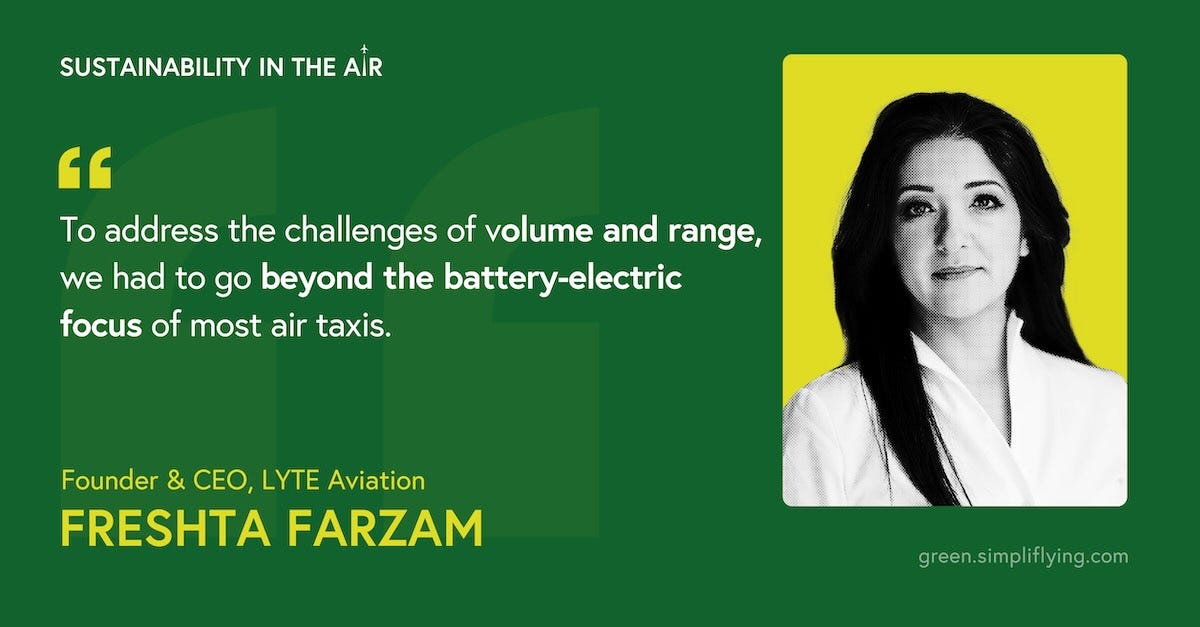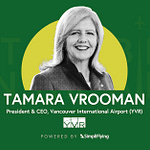In this episode of our ‘Sustainability in the Air’ podcast, Shashank Nigam, CEO of SimpliFlying, speaks with Freshta Farzam, founder and CEO of LYTE Aviation, about the company’s innovative approach to developing a 40-seater eVTOL (electric vertical takeoff and landing) aircraft for regional travel and cargo transport. Farzam shares insights into LYTE Aviation’s technology, market strategy, and vision for the future of sustainable regional air travel.
Here are the key highlights of the conversation:
The inspiration behind LYTE Aviation’s large-capacity eVTOL (2:45)
LYTE Aviation’s hybrid propulsion system and design choices (11:10)
Target markets and replacing existing transportation modes (12:50)
Infrastructure requirements and partnerships (21:50)
Diverse product portfolio and market approach (28:10)
Funding situation and future plans (32:45)
Addressing humanitarian and business aviation needs (35:25)
Rapid Fire! (43:30)
Keep reading for a detailed overview of the episode.
LYTE Aviation’s leap in eVTOL design
While much of the eVTOL industry has focused on smaller air taxis for 2-5 passengers, LYTE Aviation has taken a different approach by developing a 40-seat eVTOL aircraft called the LA-44 ‘SkyBus’.
Farzam views this larger capacity as a major opportunity for decarbonising regional air travel. With a 1,000 km range, the SkyBus opens up new possibilities for short- and medium-range flights.
The concept draws inspiration from the Fairey Rotodyne, a 1950s aircraft that combined helicopter and airplane capabilities. However, unlike the Rotodyne, which was notoriously loud, LYTE’s eVTOL aims to offer low emissions and cost-effective operation with minimal noise.
LYTE's hybrid propulsion system combines four turbine-powered propellers near the fuselage and four smaller electric propellers at the tips of the tilt-wings. The turbine engines will run on sustainable aviation fuel (SAF), while the electric motors will be powered by hydrogen fuel cells. This allows LYTE Aviation to overcome the current limitations of battery technology while still leveraging the benefits of electric propulsion, says Farzam.
Four ways LYTE Aviation’s eVTOL could transform regional transportation
1. Replacing ferry routes and creating new regional connections
In 2023, LYTE Aviation partnered with the Advanced Air Mobility (AAM) Institute to launch alternatives to ferry routes in the US. They also published a white paper examining how LYTE’s SkyBus could serve the Bainbridge Island–Seattle–Redmond route, currently operated by ferries.
Farzam explains, “We looked at [the Bainbridge Island–Seattle–Redmond] route and we saw the pain point. For example, Microsoft is one of the largest employers in that area with 53,000 employees. To get to the office, employees have to take ferries from Bainbridge Island to go to Seattle, and they pay $29 per ticket for the ferry.”
By offering a faster, more direct alternative, LYTE Aviation could significantly reduce travel times and potentially decrease the overall environmental impact of regional transportation.
“If we take the SkyBus, and you have a vertiport in Bainbridge Island, and another one at the Microsoft campus, you can get there in 15 minutes,” says Farzam.
Farzam views ferry operators as a crucial partner in creating new air connections. For example, in the Bahamas, where ~98% of the islands are uninhabited, ferry operators could integrate their ferry and air services. This could potentially stimulate economic growth in the region by promoting tourism and local business development through improved connectivity and access, she adds.
LYTE is also exploring operations on short routes in Europe, such as Hamburg to Amsterdam, and Paris to Amsterdam.
2. Flexible solutions for cargo and business aviation
LYTE Aviation is also developing a cargo version of the SkyBus, called the SkyTruck. The SkyTruck is similar in its specifications to SkyBus, but with the seats removed, and can carry up to 4.5 tonnes of cargo. This flexibility can offer faster and more direct delivery options for a variety of goods.
In addition to the SkyTruck, LYTE Aviation is also exploring a 19-seater variation of the SkyBus for business aviation.
Farzam explains, “Until last year, we were focusing only on mass transit with the Sky Bus and the SkyTruck. This year, we noticed after the conversations with some business jetliners from Brazil and the US that there is a big market for business aviation, especially with 19 seats.”
3. Addressing humanitarian needs
LYTE Aviation is also considering humanitarian response applications of their aircraft, where the range can go up to 2,000 km. This could be particularly valuable in disaster relief situations, allowing for rapid response and evacuation capabilities in areas with limited infrastructure, says Farzam.
Farzam emphasises the immediate potential of the TurboBus in disaster situations: “We can evacuate faster, drop off, pick up and just be there quicker. We announced [the TurboBus] because we know that by 2030, at least, the numbers of natural disasters worldwide will also increase largely due to climate change.”
4. Ecosystem approach to sustainable aviation
Farzam stresses the importance of collaboration across the industry, recognising that the implementation of LYTE’s aircraft requires collaboration across the aviation industry.
She shares potential partnerships with existing transportation providers, “Our customers are existing regional airlines who can use our SkyBus in regions they already cover. They can also support us to create new routes. Even ferry operators can transition to air operations, using our SkyBus for shuttle services.”
However, these customers will only invest in LYTE’s aircraft if the required infrastructure is in place, making partnerships with vertiports and airports in Europe and the US essential, says Farzam.
Overall, the company seeks to balance immediate technological development with an ambitious long-term vision for the future of aviation, as Farzam explains:
“This is an aircraft that I want to see writing a legacy. Our goal is to introduce a new category of aircraft that will be seen flying all over the world. In many places, we have a target of 2000 pre-orders within the next two years.”
‘Sustainability in the Air’ is the world’s leading podcast dedicated to sustainable aviation. Through in-depth conversations with top aviation leaders, we break through the clutter and provide a clear roadmap for a net-zero future.
For September 2024, we’re proud to feature Estuaire as our exclusive Sponsor of the Month. Estuaire is an aviation and climate data platform designed to help aviation brands make smarter, more informed decisions, especially when it comes to addressing non-CO2 impacts. Discover how they can support your sustainability goals.













